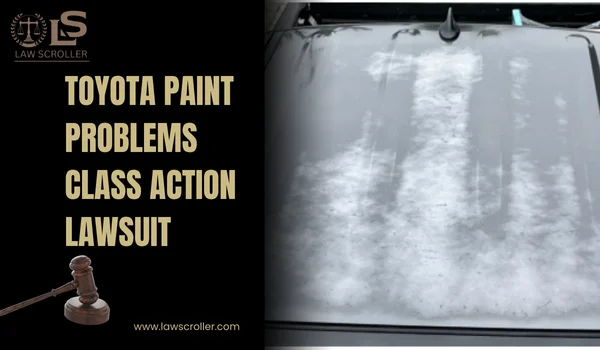Why This Lawsuit Matters
Imagine buying a brand-new car, expecting it to last for years, only to see the paint peel, chip, or fade far too soon. That’s the issue at the heart of the Toyota paint problems class action lawsuit. For everyday car owners, this case matters because it’s about holding a major automaker accountable for defects that can reduce the value and appearance of your vehicle. More importantly, it could mean money back or free repairs for those affected.
Background: What Is This Lawsuit About?

The lawsuit claims that certain Toyota vehicles came with defective paint that is prone to premature peeling, flaking, or fading. Instead of lasting for years, as most car owners expect, the paint allegedly starts to fail well before its time.
- Plaintiffs (the car owners filing the suit) argue that Toyota knew or should have known about these paint issues.
- They also claim Toyota did not properly warn buyers or cover the paint problems under warranty.
- The lawsuit is a class action, which means it combines the claims of many Toyota owners into one case against the automaker.
This case isn’t about minor scratches from normal wear and tear — it’s about large-scale paint defects that affect the car’s look, resale value, and sometimes even its protection against rust.
Who’s Affected?
The Toyota paint problems lawsuit could impact thousands of car owners. Specifically:
- Owners of Toyota models with factory paint in Blizzard Pearl (white) and Super White colors are often mentioned in complaints.
- Vehicles from the 2010s through early 2020s have been flagged in legal filings and online forums.
- Both current and former owners may be eligible if their cars suffered from premature paint problems.
If you’ve paid out-of-pocket for repainting, or if your vehicle lost resale value due to peeling paint, this lawsuit could matter to you.
Timeline of Key Events
Here’s a simple breakdown of how the case has unfolded so far:
- 2019–2020: Car owners begin reporting widespread Toyota paint issues online and filing complaints with regulators.
- 2020: Toyota issues a Warranty Enhancement Program for some vehicles, but many owners claim it doesn’t cover everyone.
- 2021: Class action lawsuits are filed, alleging Toyota failed to properly fix the problem.
- 2022–2023: Courts review motions to dismiss and allow parts of the lawsuits to move forward.
- 2024: Settlement discussions and case updates continue, with consumers watching for potential outcomes.
What’s at Stake
For Toyota owners, the stakes are both financial and practical.
- Repair costs: A full repaint job can cost anywhere from $2,000 to $5,000 or more.
- Resale value: Cars with peeling paint are harder to sell and often fetch lower prices.
- Fair treatment: The lawsuit is also about making sure Toyota addresses consumer complaints fairly.
For Toyota, millions of dollars could be on the line in terms of settlement payments, warranty extensions, or reimbursement programs.
What to Watch Next
If you’re following the Toyota paint class action lawsuit case update, here’s what to keep an eye on:
- Settlement talks: Courts may push both sides toward a settlement, which could mean free repairs or refunds for owners.
- Eligibility lists: If a settlement happens, the court will release a list of which models and years qualify.
- Deadlines: Consumers will need to file claims by certain dates to receive any compensation.
- Court rulings: If no settlement is reached, the case could go to trial — but that takes longer.
FAQs About the Toyota Paint Problems Lawsuit
- Am I eligible to join the lawsuit?
If you own or leased a Toyota with Blizzard Pearl or Super White paint that has peeling or flaking issues, you may be included. Details will depend on the court’s eligibility list. - Do I need a lawyer to file a claim?
Not necessarily. In a class action, the lawyers represent the entire group. If there’s a settlement, you usually just fill out a claim form. - How much money could I get?
It depends on the final settlement. Some people may get reimbursement for repainting costs, while others may qualify for free repairs. - What if I already sold my Toyota?
Former owners might still be eligible if they paid for repainting or lost resale value due to paint problems. - When will this case be decided?
Class actions move slowly. It may take months — or even years — before a final resolution. Keep an eye on official court updates. - Where can I find updates?
Official notices will be posted on the settlement administrator’s website (if approved) and in court filings.
Final Word
The Toyota paint problems class action lawsuit shows how everyday consumers can come together to hold a major company accountable. If you’ve noticed peeling or flaking paint on your Toyota, it’s worth keeping an eye on the case updates and any settlement announcements.


 Oliver Johnson is LawScroller’s Senior Legal Correspondent specializing in civil litigation, class actions, and consumer lawsuit coverage. He breaks down complex settlements and court decisions into clear, practical guidance for readers.
Oliver Johnson is LawScroller’s Senior Legal Correspondent specializing in civil litigation, class actions, and consumer lawsuit coverage. He breaks down complex settlements and court decisions into clear, practical guidance for readers.